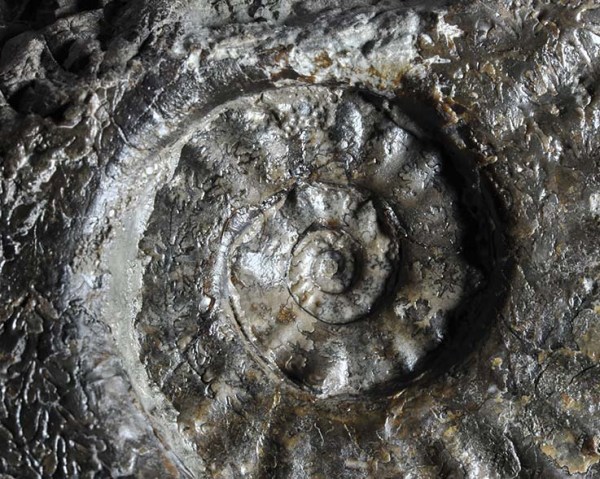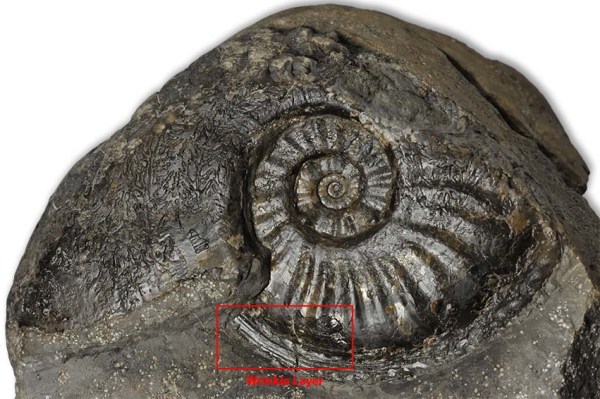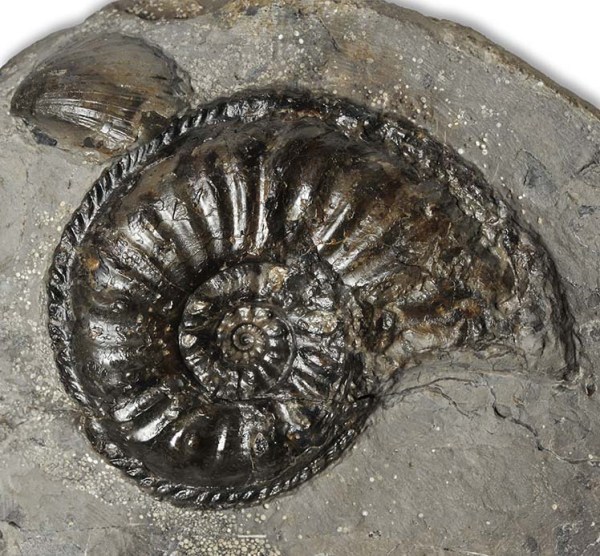
Amaltheus gibbosus (SCHLOTHEIM 1820), Prince Charles Cave, Isle of Skye, 8.5 cm
In my Amaltheidae post (link) I had shown you a very nice small specimen of Amaltheus gibbosus, that I had purchased from Mike Forster via Mike Marshall´s shop.
Quite recently, I had to succumb to temptation again ;-), when Mike offered a larger calcite preserved Amaltheus gibbosus from Skye – Amaltheus gibbosus according to literature is not common on the Yorkshire coast so I had basically given up finding one myself.
I was grateful to be able to plug that hole in my collection with these beautiful specimen, but why is it just not the same as finding one yourself ?
Some of the better finds start inconspicuous – and it was just like that with the following find I´d like to present you now.
When picked it up as a beach pebble at Hawsker it was then just showing a whorl cross section on the surface, and I usually investigate to see if there´s more of it…
I tried to split the rock at the ammonite, but another piece of rock broke off and showed the cross section of a second ammonite – time to bag all the pieces and take a better look during preparation !

Specimen as found with section of whorls on both pieces, oolitic structure can be seen
Now when I removed the matrix plug in the umbilicus of the first ammonite I knew it was something special: There are characteristic spines on the inner whorls – It´s an Amaltheus gibbosus !

Amaltheus gibbosus (SCHLOTHEIM 1820), Hawsker Bottoms, inner whorl, width of view ca. 2.5 cm
With this one I found after prep (I had to remove some of the remnants of the badly crushed body chamber) that it does show a bit of what is thought to be similar to the black wrinkle layer on a nautilus : A bit of specially formed shell secreted on the outer side of the inner whorl to prepare for buildup of a new bit of body chamber and supposedly helping the animal to get a better “grip” of the mantel on the shell. QUENSTEDT in 1885 called them “Bauchstreifen” (belly stripes) since with the Amaltheidae they are consisting of spiral stripes in the dorsal overlap of the outermost whorl with the inner whorl.

Amaltheus gibbosus (SCHLOTHEIM 1820), max. width 9 cm, remnants of wrinkle layer marked
What would the second one that I had broken in two during my splitting attempt be ?
I quickly glued back together the pieces…
Preparation was not easy, it is never with spiny specimen. Luckily the matrix was just soft enough so I could air abrade the inner whorl and the keel with high pressure, revealing this second, even nicer specimen of Amaltheus gibbosus.

Amaltheus gibbosus (SCHLOTHEIM 1820), Hawsker Bottoms, 6 cm diameter
There was something else about this rock that I somehow remembered from an earlier find : The matrix is oolitic, i.e. there are many small calcareous, sphaerical grains made up of thin concentric layers embedded in the rock, characteristic for some of the ironstone seams on the coast, in this case I think it must be the Raisdale seam.
I knew I had seen this before on the underside of an Amaltheus fragment that I had found at Staithes in 1994 and labeled as Amaltheus margaritatus. When I looked at it again in the drawer now, I realized it is also an Amatheus gibbosus, the spiny inner whorls had just been badly eroded which had made recognition difficult ! I must have subconciously known it was something special though, since I held on to it for such a long time even though it´s just a fragment…

Amaltheus gibbosus (SCHLOTHEIM 1820), Staithes, width of fragment 5 cm
These 3 specimen really show that you learn so much more when you try to find an ammonite species yourself : First of all PATIENCE but secondly a lot more about the lithology of the beds you´re likely to find the ammonite in…
And then there´s the story behind the find, the memories and the “relationship” (I put this in quotes – it somehow sounds so nerdy) you build up when prepping the fossil.
I´m sure both Mike Marshall and Mike Forster did have the same sort of feelings when finding and prepping the fossils they´ve sold to me, since it shows in the quality of their prepwork. But this does not translate in any other way – memories can´t be sold – that´s why finding the fossil yourself is best, you just look at it differently, because you know it´s history from when it just was a pebble on the beach to the final state when you put it in your drawer or display (or your blog…).
AndyS










